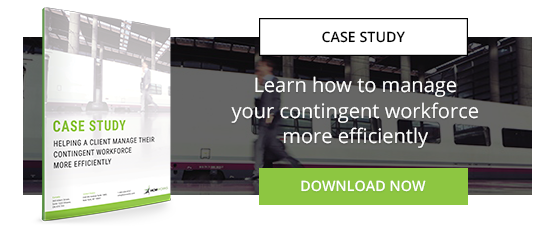Supplier performance management (SPM) is a business practice that is used to measure, analyze, and manage your supplier’s performance in an effort to cut costs, alleviate risks, and drive continuous improvement. It's a crucial aspect of any contingent workforce management program.
The ultimate intent of SPM is to identify potential issues and their root causes so that they can be resolved to everyone’s benefit as early as possible.
Why is supplier performance management important for your business?
Most companies rely on timely delivery, price reduction and service quality offered by their suppliers in order to gain more profit. As a result, the successful management of supplier performance directly affects the quality of the whole supply chain.
That's why it's essential to establish an efficient mechanism to enhance it, accelerate its improvement and ensure the quality of services and/or products.
Through the evaluation and comparison of supplier performance, companies can ensure and maintain the best service possible, and eliminate suppliers who fail to comply with performance requirements
Not only that, but supplier performance management sets the stage for suppliers to understand the customer's needs and expectations. This can result in a value-add strategic partnership in which the suppliers' performance and competencies increasingly grow. The strength of future success is dependent on a mutual ability to attain and maintain market leadership with the best technology and business processes.
Supplier performance management brings together the components of supplier segmentation, risk management, metrics management, and consequence management, to actively manage important supplier relationships in a consistent, objective method that provides actionable data.
That data can then be used for your business to make informed decisions on supplier selection.
How can you measure supplier performance?
For some companies, strategic supplier partnerships have become important enough to warrant considerable investment of time and effort in the development of performance metrics. Nonetheless, the fact that many supplier partnerships reside within the gaps of organizational lines of accountability, or cut across them, metrics are much more difficult to put in place, and more likely to be neglected.
As companies engage in greater numbers of supplier partnerships, and as partnerships become increasingly important in terms of strategic and financial impact, senior management has begun to pay more attention to supplier partnership performance metrics. This is a welcome development, for as the old adage goes: “if you can’t measure it, you can’t manage it.”
In our experience, managing contingent workforces for our clients across North America, the biggest challenges relate to performance measurement, and these have a great deal to do with the process by which metrics are developed and implemented.
Partnership metrics must be created and used in a context which, by its nature, crosses both external and internal organizational boundaries. In our view, this reality needs to be understood and managed if companies are to successfully implement metrics on individual partnerships and across their entire partnership portfolio.
Here at HCMWorks, we recommend the following six principles for implementing partnership metrics:
- Ensure comparability of metrics across partnerships.
- Define and discuss metrics with partnership representatives and create performance metrics for both sides.
- Ensure clarity around implications of partner performance - good and poor.
- Implement a process for auditing partnership performance.
- Link partnership performance with individual performance evaluation.
- Create a forum for reviewing and acting on partnership performance data.
Any company that deploys effective supplier performance management ensures that a supplier’s performance meets the expectations defined in the contract and against market norms. It includes the management of actual performance, identification of performance gaps and agreement of actions to achieve desired performance levels.
Supplier performance management not only ensures that those benefits identified in the contracting stage are delivered, but that value delivery continues for the life of the contract.
As companies increasingly focus on their core competencies and outsource a greater percentage of work, their success becomes ever more dependent on the performance of strategic suppliers. Ultimately, the objective of supplier performance management is to improve the performance of all parties involved in the contract and Service Level Agreement.
Are you looking for more information on building a successful SPM strategy? Read our blog, How to Implement a Supplier Performance Management (SPM) Strategy.
Alternatively, you can contact our team of contingent workforce experts today. HCMWorks is a contingent workforce service provider helping organizations gain better access to talent through the use of independent contractors, consultants, temporary workers, freelancers and other non-payrolled employees.
We provide the expertise, the technology, and processes to help you reduce your workforce costs, mitigate against misclassification and co-employment risks, and increase the efficiency and timeliness of your contingent recruitment process.



